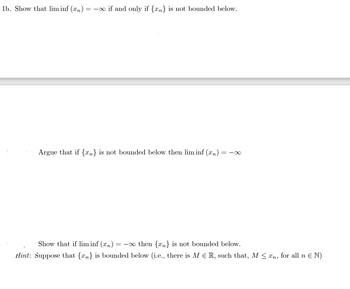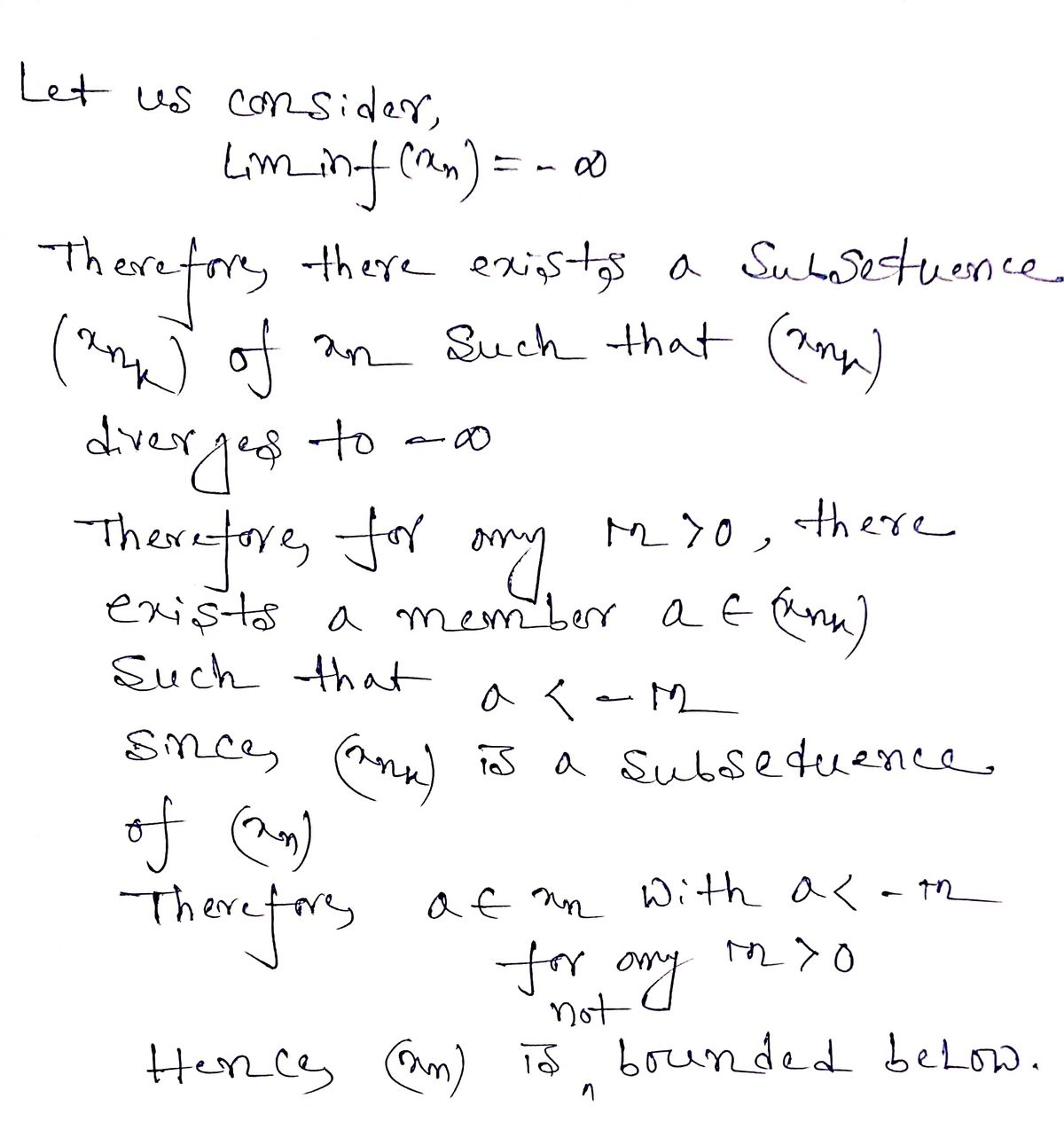
Advanced Engineering Mathematics
10th Edition
ISBN: 9780470458365
Author: Erwin Kreyszig
Publisher: Wiley, John & Sons, Incorporated
expand_more
expand_more
format_list_bulleted
Question

Transcribed Image Text:### Problem 1b
**Objective:**
Show that the limit inferior of a sequence \( \{x_n\} \), denoted as \(\liminf(x_n) = -\infty\), if and only if the sequence \( \{x_n\} \) is not bounded below.
---
**Tasks:**
1. **Argue that if \( \{x_n\} \) is not bounded below, then \(\liminf(x_n) = -\infty\).**
This involves demonstrating that when there is no real number that serves as a lower bound for the sequence, the limit inferior extends to negative infinity.
2. **Show that if \(\liminf(x_n) = -\infty\), then \( \{x_n\} \) is not bounded below.**
**Hint:** Suppose that \( \{x_n\} \) is bounded below, i.e., there exists an \( M \in \mathbb{R} \) such that \( M \le x_n \) for all \( n \in \mathbb{N} \). Consider the contradiction that arises when \(\liminf(x_n) = -\infty\) under this assumption.
---
**Explanation:**
The exercise requires establishing a bi-conditional relationship between the limit inferior reaching negative infinity and the sequence being unbounded below. You will need to consider both directions of the statement separately:
- **From unbounded below to \(-\infty\):** Show that if no lower bound exists, then the eventual behavior of the sequence's limit inferior is unbounded in the negative direction.
- **From \(-\infty\) to unbounded below:** Using the hint provided, attempt proof by contradiction or direct proof showing if the \(\liminf\) is \(-\infty\), the sequence must lack a lower bound.
This task develops an understanding of the concept of limit inferior in relation to the boundedness properties of sequences, a fundamental aspect in analysis.
Expert Solution
arrow_forward
Step 1: First part

Step by stepSolved in 3 steps with 2 images

Knowledge Booster
Similar questions
- 12) find the limitarrow_forwardWhat is the limit lim x→3 √x³ 2-5 x - 3 - 3 27 10 9 10 +∞ Does not exist ?arrow_forward6. Explain why the limits lim f(x+h) – f(x) and lim ) -f (x) h ZX Z-X if are each initially in the form -. Why would cancelling a common factor of h or z - x be likely to resolve this inde- terminate form?arrow_forward
arrow_back_ios
arrow_forward_ios
Recommended textbooks for you
 Advanced Engineering MathematicsAdvanced MathISBN:9780470458365Author:Erwin KreyszigPublisher:Wiley, John & Sons, Incorporated
Advanced Engineering MathematicsAdvanced MathISBN:9780470458365Author:Erwin KreyszigPublisher:Wiley, John & Sons, Incorporated Numerical Methods for EngineersAdvanced MathISBN:9780073397924Author:Steven C. Chapra Dr., Raymond P. CanalePublisher:McGraw-Hill Education
Numerical Methods for EngineersAdvanced MathISBN:9780073397924Author:Steven C. Chapra Dr., Raymond P. CanalePublisher:McGraw-Hill Education Introductory Mathematics for Engineering Applicat...Advanced MathISBN:9781118141809Author:Nathan KlingbeilPublisher:WILEY
Introductory Mathematics for Engineering Applicat...Advanced MathISBN:9781118141809Author:Nathan KlingbeilPublisher:WILEY Mathematics For Machine TechnologyAdvanced MathISBN:9781337798310Author:Peterson, John.Publisher:Cengage Learning,
Mathematics For Machine TechnologyAdvanced MathISBN:9781337798310Author:Peterson, John.Publisher:Cengage Learning,


Advanced Engineering Mathematics
Advanced Math
ISBN:9780470458365
Author:Erwin Kreyszig
Publisher:Wiley, John & Sons, Incorporated

Numerical Methods for Engineers
Advanced Math
ISBN:9780073397924
Author:Steven C. Chapra Dr., Raymond P. Canale
Publisher:McGraw-Hill Education

Introductory Mathematics for Engineering Applicat...
Advanced Math
ISBN:9781118141809
Author:Nathan Klingbeil
Publisher:WILEY

Mathematics For Machine Technology
Advanced Math
ISBN:9781337798310
Author:Peterson, John.
Publisher:Cengage Learning,

